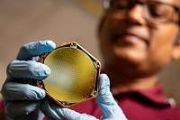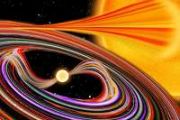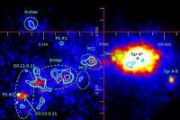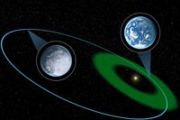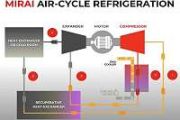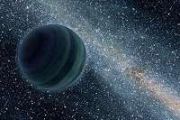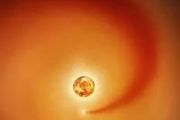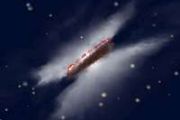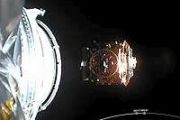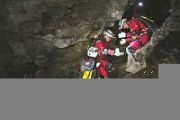
Copernical Team
A blueprint for life forms on Mars
 The extremely salty, very cold, and almost oxygen-free environment under the permafrost of Lost Hammer Spring in Canada's High Arctic is the one that most closely resembles certain areas on Mars. So, if you want to learn more about the kinds of life forms that could once have existed - or may still exist - on Mars, this is a good place to look.
After much searching under extremely difficul
The extremely salty, very cold, and almost oxygen-free environment under the permafrost of Lost Hammer Spring in Canada's High Arctic is the one that most closely resembles certain areas on Mars. So, if you want to learn more about the kinds of life forms that could once have existed - or may still exist - on Mars, this is a good place to look.
After much searching under extremely difficul Go ahead for second round of micro-launcher payload competition
 On 20 June 2022, the German Space Agency (DLR) launched the second round of its competition for zero-cost flights of small satellites on microlaunchers developed and constructed in Germany. This marks the start of the implementation phase for a total of three additional flights being offered by the space companies Isar Aerospace Technologies GmbH and Rocket Factory Augsburg AG in 2023 and 2024.
On 20 June 2022, the German Space Agency (DLR) launched the second round of its competition for zero-cost flights of small satellites on microlaunchers developed and constructed in Germany. This marks the start of the implementation phase for a total of three additional flights being offered by the space companies Isar Aerospace Technologies GmbH and Rocket Factory Augsburg AG in 2023 and 2024. China develops new coating for spacecraft thermal control
 Chinese scientists have developed a metallic-based thermal-control coating for the Shenzhou-14 crewed spaceship that will protect the taikonauts from extreme heat and cold during their six-month stay in orbit.
The new coating works in two ways: providing low solar absorption to help reduce the sun's effect on the spacecraft's interior temperature; and providing low infrared emittance to bl
Chinese scientists have developed a metallic-based thermal-control coating for the Shenzhou-14 crewed spaceship that will protect the taikonauts from extreme heat and cold during their six-month stay in orbit.
The new coating works in two ways: providing low solar absorption to help reduce the sun's effect on the spacecraft's interior temperature; and providing low infrared emittance to bl Chinese official says its Mars sample mission will beat NASA back to Earth
 A senior Chinese space official said on Monday the country is on track to bring back rocks from the surface of Mars two years ahead of the planned joint effort by NASA and the European Space Agency to do the same thing.
Sun Zezhou, the chief designer of China's first Mars mission, Tianwen 1, said in a talk celebrating the 120th anniversary of Nanjing University, that China is ready to send
A senior Chinese space official said on Monday the country is on track to bring back rocks from the surface of Mars two years ahead of the planned joint effort by NASA and the European Space Agency to do the same thing.
Sun Zezhou, the chief designer of China's first Mars mission, Tianwen 1, said in a talk celebrating the 120th anniversary of Nanjing University, that China is ready to send InSight gets a few extra weeks of Mars science
 As the power available to NASA's InSight Mars lander diminishes by the day, the spacecraft's team has revised the mission's timeline in order to maximize the science they can conduct. The lander was projected to automatically shut down the seismometer - InSight's last operational science instrument - by the end of June in order to conserve energy, surviving on what power its dust-laden solar pan
As the power available to NASA's InSight Mars lander diminishes by the day, the spacecraft's team has revised the mission's timeline in order to maximize the science they can conduct. The lander was projected to automatically shut down the seismometer - InSight's last operational science instrument - by the end of June in order to conserve energy, surviving on what power its dust-laden solar pan Tyvak International completes Critical Design Review of Deep Space Bound Milani nanosat
 Terran Orbital Corporation (NYSE: LLAP), a global leader in satellite solutions, primarily serving the aerospace and defense industries, has announced its wholly-owned subsidiary, Tyvak International SRL, has together with its partners, achieved full Critical Design Review of the Milani spacecraft.
A critical component of the Hera planetary defense mission,
Terran Orbital Corporation (NYSE: LLAP), a global leader in satellite solutions, primarily serving the aerospace and defense industries, has announced its wholly-owned subsidiary, Tyvak International SRL, has together with its partners, achieved full Critical Design Review of the Milani spacecraft.
A critical component of the Hera planetary defense mission, MOONRISE: LZH and TU Berlin bring 3D printing to the Moon with laser and AI
 3D printing on the Moon: Scientists from the Laser Zentrum Hannover e.V. (LZH) and the Technische Universitat Berlin (TU Berlin) are planning a flight to the Moon to melt lunar dust with laser beams.
In the MOONRISE project, the research team wants to explore the question of how we can use lasers to build landing sites, roads or buildings out of lunar dust in the future. To do this, the re
3D printing on the Moon: Scientists from the Laser Zentrum Hannover e.V. (LZH) and the Technische Universitat Berlin (TU Berlin) are planning a flight to the Moon to melt lunar dust with laser beams.
In the MOONRISE project, the research team wants to explore the question of how we can use lasers to build landing sites, roads or buildings out of lunar dust in the future. To do this, the re SwRI researcher shows how elliptical craters could shed light on age of Saturn's moons
 A new SwRI study describes how unique populations of craters on two of Saturn's moons could help indicate the satellites' age and the conditions of their formation. Using data from NASA's Cassini mission, SwRI postdoctoral researcher Dr. Sierra Ferguson surveyed elliptical craters on Saturn's moons Tethys and Dione for this study, which was co-authored by SwRI Principal Scientist Dr. Alyssa Rhod
A new SwRI study describes how unique populations of craters on two of Saturn's moons could help indicate the satellites' age and the conditions of their formation. Using data from NASA's Cassini mission, SwRI postdoctoral researcher Dr. Sierra Ferguson surveyed elliptical craters on Saturn's moons Tethys and Dione for this study, which was co-authored by SwRI Principal Scientist Dr. Alyssa Rhod South Korea launches homegrown Nuri rocket in major space milestone
 South Korea successfully launched its first homegrown rocket on Tuesday, deploying a satellite into low-Earth orbit in a major milestone as the country jumps into the space race with both commercial and military implications.
The three-stage Nuri rocket blasted off from the Naro Space Center in the southern coastal town of Goheung on Tuesday afternoon. It reached its target altitude of 435
South Korea successfully launched its first homegrown rocket on Tuesday, deploying a satellite into low-Earth orbit in a major milestone as the country jumps into the space race with both commercial and military implications.
The three-stage Nuri rocket blasted off from the Naro Space Center in the southern coastal town of Goheung on Tuesday afternoon. It reached its target altitude of 435 SwRI scientists identify a possible source for Charon's red cap
 Southwest Research Institute scientists combined data from NASA's New Horizons mission with novel laboratory experiments and exospheric modeling to reveal the likely composition of the red cap on Pluto's moon Charon and how it may have formed. This first-ever description of Charon's dynamic methane atmosphere using new experimental data provides a fascinating glimpse into the origins of this moo
Southwest Research Institute scientists combined data from NASA's New Horizons mission with novel laboratory experiments and exospheric modeling to reveal the likely composition of the red cap on Pluto's moon Charon and how it may have formed. This first-ever description of Charon's dynamic methane atmosphere using new experimental data provides a fascinating glimpse into the origins of this moo 


